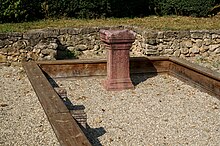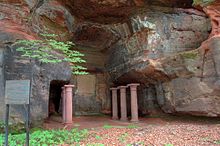Mithraeum

As mithraea (singular Mithraeum , lat. Mithraeum ) refers to the Temple of Mithras cult .
Mithraea were mostly built underground or carved into rock. For the Mithras congregations, which numbered only one to two dozen members, a relatively small cult area was sufficient. The largest known Mithraeum offered space for 80 believers. In contrast to Christianity , where correspondingly larger houses of worship were built in larger communities, in Mithraism their number, not their volume, was increased. At the height of the Mithraic cult in the 3rd century , there are said to have been 800 Mithraea in Rome alone . Since the individual Mithraea were mostly not in use for long, this high number says nothing about the number of followers. To date, the remains of over 1000 Mithraea have been archaeologically proven throughout the area of the Roman Empire .
Structural system

Most mithraea had a rectangular floor plan and a barrel vault . Due to the underground system (often in the basement of private houses within cities) each Mithraeum was built like an artificial cave and thus reminded of the birth of Mithras in a rock cave. The Romans called it spelunca . The “caves” could also have been a model of the cosmos, as the starry sky was often depicted on the ceiling of the Mithraea and sometimes some small openings let light through.
The inner layout of the Mithraea was similar to the later Christian churches, but they were oriented towards the west (sunset) and not towards the east (sunrise). The foundations show a typical tripartite division: a central aisle ( cella ) was flanked left and right by two stone-walled podiums. To the east of the temple was the entrance and at the other end of the central aisle to the west was an apse with an altar . The altar partly had seven steps, which symbolized the seven spheres or initiation steps of Mithraism. Above the altar there was a large mural or stone relief that shows the bull-killing scene ( tauroctony ) in almost all mithraea . The walls and ceilings of the mithraea were also often painted.
The believers camped on the side podiums and watched the ceremonies that the priest celebrated in the central aisle and in front of the cult image in the east. They also ate their meals on these podiums.
Destruction and decay of the Mithraea
When Christianity attained supremacy over all other religions in the Roman Empire in the 4th century, a large part of the Mithraic temples that still existed were destroyed by the Christians, the rest fell into disrepair. Around 380, for example, the heathen Libanios described in a letter to Emperor Theodosius I the extreme rage of destruction at heathen temples by "gangs of black-clad monks". Emperor Theodosius I passed a law in 391 that all pagan temples were to be closed; however, it is controversial in recent research how strictly the official statements were implemented. The image of hard religious struggles around 400, which was often drawn up in older research, was recently questioned by Alan Cameron on at least several points. In 407, however, the sons of Theodosius passed a nationwide law, according to which pagan altars had to be torn down and pagan images that were used for worship had to be removed.
In his book The archeology of religious hatred in the Roman and early medieval world , Eberhard Sauer dates destroyed pagan temples and the destruction of cultural assets ( iconoclasm , cultural vandalism ), especially in the West. This could be attributed to the fact that here (especially in Germany) the excavations were more numerous and more careful. The latter was crucial in order to determine the approximate period of destruction of the temple from finds such as coins. According to Sauer, this destruction was excessive and encompassed the whole empire:
"On the basis of the literary and archaeological evidence, there can be no doubt that the Christianization of the Roman Empire and early medieval Europe went hand in hand with the destruction of works of art on a scale never before seen in human history."

When the first excavations for the religious wars were carried out in 1905, the skeleton of a thin man, whose hands were tied behind his back with iron chains and who had apparently been buried alive , was found in the Mithra temple of Saarburg in Lorraine, which was closed and filled in with rocks . The temple showed strong traces of iconoclasm. A relief image was smashed into over 300 pieces. A similar picture was found in the (presumed) Mithras shrine in the cult cave in Zillis . The remains of a man who was probably buried in the 6th century and apparently impaled were discovered here - possibly a Mithras priest who could have been executed by Christians when the sanctuary was destroyed.
Survey and database research on the extent of temple destruction confirm the picture of lasting destruction for pagan buildings, including in the east of the empire, as the sum of the local religious struggles occurring everywhere. Building material for Christian new buildings was often extracted from destroyed pagan buildings ( Spolia ). In some cases, Christian churches were built over directly on the mithraea, as archaeological finds (e.g. Rome , Sa. Prisca) show.
By 430 the destruction of the pagan temples and statues had progressed so far that Theodoret , a Christian apologist and author of the last known writings against the pagans, wrote:
“Why do we still speak of the philosophers, emperors and generals, when the martyrs in the memory of the people became the successors of those who were called gods? Verily, their temples have been so completely destroyed that one cannot even imagine their previous location, while the building material is now dedicated to the shrines of the martyrs. "
Nevertheless, some Mithraea continued to exist for a few centuries and the Mithraic cult was probably not completely eradicated in the 6th century. For example, the main temple of Sol invictus Mithras in Baalbek (now Lebanon) was destroyed in 554 at the earliest.
List of important Mithraea
Mithraea in Germany
In Germany, the remains or reconstructions of Mithraea can be viewed in the following cities:
- Bretzenheim , Hermitage
- Dieburg (near Darmstadt ), Museum Schloss Fechenbach
- Hanau (from Erlensee-Rückingen, see Kastell Rückingen )
- Frankfurt-Heddernheim (Roman town Nida-Heddernheim )
- Gimmeldingen , City of Neustadt adW
- Heidelberg , Palatinate Museum
- Güglingen
- Cologne
- Mithraeum in Königsbrunn (near Augsburg )
- Mainz ( Mogontiacum ), consecration altars on the ball court
- Mundelsheim (Mithras Altar), with Roman cellar Ottmarsheimer Höhe
- Neuss (Legion camp Castra Novaesia )
- Osterburken
- Riegel am Kaiserstuhl (near Freiburg im Breisgau )
- Saalburg Castle (near Bad Homburg in front of the Höhe )
- Saarbrücken (Mithras Cave)
- Black Earth ( Saarland )
- Stockstadt am Main (two Mithraea in the vicinity of the Stockstadt Fort ), most of the finds in the Saalburg Museum
- Trier ( Augusta Treverorum ), Mithraeum in the temple district in the Altbachtal
Mithraea in Italy
- In Rome :
- Mithraeum of the Circus Maximus
- Barberini- Mithraeum
- Mithraeum of the Caracalla Baths
- Mithraeum of the Crypt Balbi
- Mithraeum in Via Giovanni Lanza
- Mithraeum under the Basilica of San Clemente
- Mithraeum under Santa Prisca
- Mithraeum under the Church of San Silvestro in Capite
- Mithraeum under the Church of Santo Stefano Rotondo
- several Mitraes in Ostia Antica , including the Mitreo delle Terme del Mitra
- in Marino
- in Santa Maria Capua Vetere
- in Sutri on the Via Cassia (Viterbo province)
- Mithras cave in Duino near Trieste
Mithraea in France
- Biesheim
- Mackwiller
- Sarrebourg ( France )
- Strasbourg (Kœnigshoffen district)
Mithraea in the rest of Europe
- Mithras Temple in London , England
- Mithraeum of Rudchester on Hadrian's Wall (England)
- Mithraeum of Carrawburgh on Hadrian's Wall (England)
- Mithraeum of Housesteads on Hadrian's Wall (England)
- Mithraeum of Alauna in Cumbria (England)
- Martigny in the canton of Valais , Switzerland
- Mithraeum of Kempraten (Rapperswil-Jona), Switzerland
- Mithraea of Carnuntum , Museum Carnuntinum, Bad Deutsch Altenburg near Vienna , Austria
- Mithraeum near Fertőrákos , Hungary , near the Austrian border
- Mitrej a few kilometers north of Črnomelj in Bela krajina , Slovenia
- Mithraeum from the 4th century in Jajce ( Bosnia-Herzegovina )
Mithraea in the Orient
- Mithraeum of Dura Europos (Syria)
literature
- Manfred Clauss : Mithras. Cult and mysteries. Beck, Munich 1990, ISBN 3-406-34325-2
- Ingeborg Huld-Zetsche : The Mithras cult in Roman Germania. In: Wolfgang Spickermann (Hrsg.): Religion in the Germanic provinces of Rome. Mohr Siebeck, Tübingen 2001 ISBN 3-16-147613-1 , pp. 339-359.
- Ingeborg Huld-Zetsche: The Mithras cult in Mainz and the Mithraeum on the ball court. General Directorate for Cultural Heritage, Directorate for Archeology, Mainz 2008, ISBN 978-3-935970-05-1 ( Mainz archaeological writings 7 )
- Eberhard Sauer: The archeology of religious hatred in the Roman and early medieval world . Tempus Books, Stroud 2003, ISBN 0-7524-2530-7 .
Remarks
- ↑ For comparison: today's city of Rome with 2.8 million inhabitants has "only" about 850 churches.
- ↑ “ They demolish the temples with wooden beams, stones and tools made of iron or even without these objects with hands and feet. Then they become easy prey; although they destroy the roofs, bring down the walls, throw down the statues and tear down the altars, the priests have to be silent or they have to die . ”Libanius (speech 30,8) after Sauer (2003), p. 159. It seems to have engaged in the mob, while the clergy apparently distanced themselves from this vandalism.
- ^ Alan Cameron: The Last Pagans of Rome. Oxford 2011.
- ↑ Codex Theodosianus 16, 10, 19.
- ↑ Wording in the English original: There can be no doubt on the basis of the written and archaeological evidence that the Christianization of the Roman Empire and early medieval Europe involved the destruction of works of art on a scale never before seen in human history .
- ↑ The most recent coin found was from the year 394. The man's hands were cuffed behind his back with iron handcuffs. He had no grave goods and hardly any clothes. There was no known rite that provided such bondage to the dead or injured. According to this, the man was probably locked alive in the crypt and died in it a few days later. Given the not inconsiderable value of such iron parts in late antiquity, this suggests perpetrators who had no material interests. Archaeological discussion of the Sauer case distributed throughout the book.
- ↑ Zürcher Zeitung, March 17, 2003: "The cult of men in Christian Graubünden"
- ↑ See Johannes Hahn: Violence and Religious Conflict. The clashes between Christians, Gentiles and Jews in the east of the Roman Empire (from Constantine to Theodosius II) . Berlin 2004 ( Klio Beihefte, NF, Vol. 8).







